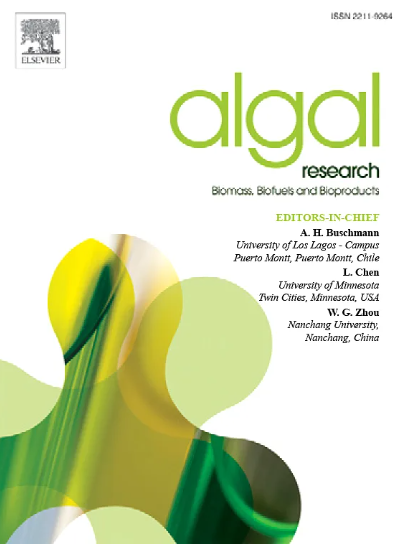Edible fungi pellets as an effective carrier of microalgae biomass and fish waste hydrolysates
IF 4.5
2区 生物学
Q1 BIOTECHNOLOGY & APPLIED MICROBIOLOGY
Algal Research-Biomass Biofuels and Bioproducts
Pub Date : 2025-06-11
DOI:10.1016/j.algal.2025.104139
引用次数: 0
Abstract
Microalgae are a promising resource for food and feed, but their large-scale application is limited by the high cost of biomass harvesting. Fungal-assisted bioflocculation offers a sustainable alternative; however most reported fungal strains are inedible, limiting their use in food and feed applications.
This study evaluates the efficiency of the edible fungi Pleurotus pulmonarius LBM105 and Lentinus sajor-caju LBM266 to flocculate four native microalgae strains from Misiones, Argentina. The effect of a sugarcane bagasse extract (SBE) based medium on flocculation efficiency (FE) and biomass composition was assessed.
Results showed that P. pulmonarius LBM105 pellets obtained in malt extract (ME) medium achieved a FE of 96 % after 24 h when co-cultivated with G. emersonii CMI015. In contrast, L. sajor-caju LBM266 pellets exhibited a lower FE (65–71 %) in the standard medium but reached 100 % in SBE medium when co-cultivated with CMI015 and CMI016. ATR-FTIR analysis suggested the involvement of amino, amide, phosphate, hydroxyl, and carboxyl groups in fungal–microalgal interactions. Biomass characterization of the fungal-microalgae pellets (FMP) revealed compositional shifts with increased lipid and protein content in P. pulmonarius LBM105 + CMI015 pellets. FMPs were further enriched with fish waste hydrolysate (FWH). In lyophilized P. pulmonarius + CMI015 pellets, FWH supplementation increased both lipid, protein and total phenolic content (TPC) levels, while in L. sajor-caju + CMI016 only TPC increases. This strategy of FWH enrichment using lyophilized FMPs as carriers represents a sustainable method for incorporating bioactive compounds into biomass. These findings highlight the potential of FWH-enriched fungal–microalgae pellets for use in food and feed applications.
食用菌微球作为微藻生物量和鱼类废弃物水解物的有效载体
微藻是一种很有前途的食物和饲料资源,但其大规模应用受到生物质收获成本高的限制。真菌辅助生物絮凝提供了一种可持续的替代方案;然而,大多数报道的真菌菌株是不可食用的,限制了它们在食品和饲料中的应用。研究了食用菌Pleurotus pulmonarius LBM105和Lentinus sajor-caju LBM266对阿根廷Misiones四种本地微藻的絮凝效果。研究了蔗渣提取物(SBE)培养基对絮凝效果和生物量组成的影响。结果表明,在麦芽提取物(ME)培养基中获得的肺假单胞菌LBM105微球与麦氏G. emersonii CMI015共培养24 h后,FE达到96%。相比之下,L. sajori -caju LBM266微球在标准培养基中表现出较低的FE(65 - 71%),而在SBE培养基中与CMI015和CMI016共培养时达到100%。ATR-FTIR分析表明,真菌与微藻的相互作用涉及氨基、酰胺、磷酸盐、羟基和羧基。真菌微藻球团(FMP)的生物量表征表明,随着P. pulmonarius LBM105 + CMI015球团中脂质和蛋白质含量的增加,其组成发生了变化。用鱼废水解液(FWH)进一步富集FMPs。在冻干P. pulmonarius + CMI015颗粒中,添加FWH增加了脂质、蛋白质和总酚含量(TPC)水平,而在L. samajor -caju + CMI016中仅增加了TPC。这种利用冻干FMPs作为载体的FWH富集策略代表了一种将生物活性化合物纳入生物质的可持续方法。这些发现突出了富fwh真菌微藻颗粒在食品和饲料应用中的潜力。
本文章由计算机程序翻译,如有差异,请以英文原文为准。
求助全文
约1分钟内获得全文
求助全文
来源期刊

Algal Research-Biomass Biofuels and Bioproducts
BIOTECHNOLOGY & APPLIED MICROBIOLOGY-
CiteScore
9.40
自引率
7.80%
发文量
332
期刊介绍:
Algal Research is an international phycology journal covering all areas of emerging technologies in algae biology, biomass production, cultivation, harvesting, extraction, bioproducts, biorefinery, engineering, and econometrics. Algae is defined to include cyanobacteria, microalgae, and protists and symbionts of interest in biotechnology. The journal publishes original research and reviews for the following scope: algal biology, including but not exclusive to: phylogeny, biodiversity, molecular traits, metabolic regulation, and genetic engineering, algal cultivation, e.g. phototrophic systems, heterotrophic systems, and mixotrophic systems, algal harvesting and extraction systems, biotechnology to convert algal biomass and components into biofuels and bioproducts, e.g., nutraceuticals, pharmaceuticals, animal feed, plastics, etc. algal products and their economic assessment
 求助内容:
求助内容: 应助结果提醒方式:
应助结果提醒方式:


